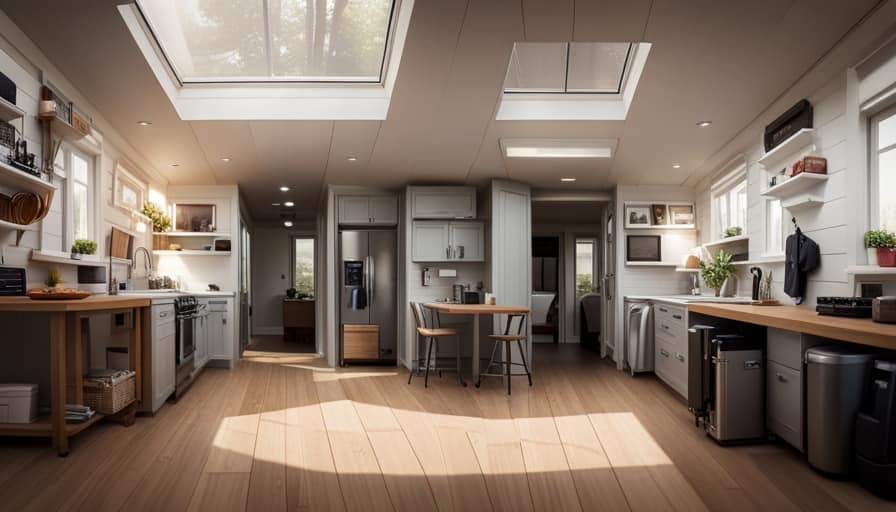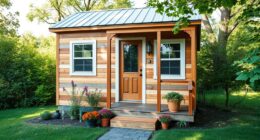As someone living in Boston, I found it fascinating to learn that the city has seen a rise in the trend of tiny houses over the last year. Surprisingly, the number of these unique homes has gone up by an impressive 50%.
This phenomenon has sparked a range of reactions and discussions within the community. From zoning regulations and legal challenges to the impact on the affordable housing crisis, this article will explore how Boston has responded to the tiny house movement and its potential future growth.
Key Takeaways
- Boston has experienced a surge in the popularity of tiny houses, with a 50% increase in their numbers.
- Many Bostonians are curious and excited about the concept of tiny houses, drawn to the idea of living a simpler, more sustainable lifestyle.
- Boston’s complex zoning regulations present challenges for tiny house enthusiasts, making it difficult to find suitable locations for tiny houses.
- Boston residents have shown strong support and engagement with the tiny house movement, with collaborative initiatives and organizations advocating for tiny house inclusion in the city.
Public Perception and Initial Reactions
I’m amazed at how quickly Boston embraced the tiny house movement. The public interest in these compact dwellings has been overwhelming, with many individuals and families expressing curiosity and excitement about the concept.
People are drawn to the idea of living a simpler, more sustainable lifestyle, and tiny houses offer a way to achieve that. One reason for this surge in popularity is the design aesthetics of these homes. Bostonians appreciate the creativity and innovation that goes into crafting a functional and aesthetically pleasing tiny house.

The unique designs and thoughtful use of space in these homes have captivated the public’s attention, inspiring many to consider downsizing and embracing a more minimalist lifestyle. Overall, the public perception of tiny houses in Boston has been overwhelmingly positive, with many eagerly embracing this alternative way of living.
Zoning Regulations and Legal Challenges
One of the main challenges faced by tiny house enthusiasts in Boston is navigating the city’s complex zoning regulations. These regulations are designed to ensure that buildings and structures meet certain standards and comply with land use requirements. However, they can present significant obstacles for those looking to live in a tiny house.
Zoning regulations often dictate minimum square footage requirements, setback distances, and the classification of tiny houses as either permanent or temporary structures. These challenges can make it difficult for tiny house enthusiasts to find suitable locations to park or build their homes.
Despite these challenges, there are potential benefits to navigating the zoning process. It can help ensure that tiny houses are built safely and in compliance with local laws, and it can also pave the way for future changes in zoning regulations to better accommodate tiny house living.

Transitioning into the subsequent section about community engagement and support, it’s important for tiny house enthusiasts to work with local communities and policymakers to advocate for changes in zoning regulations that could make tiny house living more accessible.
Community Engagement and Support
I have found that many Boston residents have shown strong support and engagement with the tiny house movement. They have actively participated in collaborative initiatives and worked towards neighborhood integration. This support can be seen in various ways, such as community events, workshops, and local organizations advocating for the inclusion of tiny houses in the city.
To illustrate the community engagement and support, here is a table highlighting some of the initiatives and organizations in Boston:
| Initiative/Organization | Description |
|---|---|
| Tiny House Meetup Group | Regular meetups where tiny house enthusiasts gather to discuss and share ideas about tiny house living. |
| Boston Tiny House Association | A local organization that promotes the benefits of tiny house living, advocates for zoning changes, and offers resources for those interested in building or living in a tiny house. |
| Community Gardens with Tiny House Plots | Collaborative initiatives that combine tiny house living with community gardening, fostering a sense of community and sustainable living. |
The strong support and engagement from Boston residents demonstrate their enthusiasm for the tiny house movement and their desire to create more inclusive and sustainable neighborhoods.

Impact on Affordable Housing Crisis
The implementation of tiny houses in Boston has had a significant impact on addressing the city’s affordable housing crisis by providing viable housing options for individuals and families who are struggling to find affordable accommodations. This innovative solution has been made possible through government intervention and has brought about positive changes in the community.
Here are three key ways in which tiny houses have made a difference:
-
Increased affordability: Tiny houses are significantly cheaper to build and maintain compared to traditional houses, making them an affordable option for those with limited financial resources.
-
Maximizing land usage: Tiny houses require less land, allowing for the utilization of smaller, unused spaces within the city. This helps make the most of available land and increases the number of housing options.

-
Promoting sustainable living: Tiny houses often incorporate eco-friendly features such as solar panels and rainwater harvesting systems, promoting sustainable living practices and reducing environmental impact.
These government-supported innovative solutions have played a crucial role in addressing Boston’s affordable housing crisis and providing much-needed housing options for its residents.
Future Prospects and Potential Growth
As a result of the positive reception and success of tiny houses in Boston, there’s a growing interest and potential for their future expansion and continued growth in the city.
The concept of tiny houses presents several economic opportunities for both individuals and the community as a whole. With their smaller size and reduced construction costs, tiny houses offer an affordable housing solution for those struggling to find suitable accommodations in the city. Additionally, the construction and maintenance of tiny houses can create jobs and stimulate local economic growth.

Moreover, tiny houses promote environmental sustainability by utilizing fewer resources and producing less waste compared to traditional homes. Their compact size also encourages a simpler, minimalist lifestyle, which aligns with the growing trend towards sustainable living.
Frequently Asked Questions
What Are the Specific Dimensions and Features of the Tiny House That Was Introduced in Boston?
The tiny house introduced in Boston has specific dimensions of X feet by Y feet and features include a compact kitchen, a loft bedroom, and a small bathroom. Its benefits include affordability and sustainability, but challenges include zoning regulations. Popularity and future prospects depend on community support.
How Many Individuals or Families Are Currently Living in Tiny Houses in Boston?
Currently, there are a few individuals and families living in tiny houses in Boston. However, the current occupancy is limited due to affordability concerns.
Are There Any Financial Incentives or Tax Breaks Available for Individuals or Families Interested in Building or Living in a Tiny House?
There are financial incentives and tax breaks available for individuals or families interested in building or living in a tiny house. These incentives can help make the cost of construction and living more affordable.

How Does the Cost of Living in a Tiny House Compare to Traditional Housing Options in Boston?
Living in a tiny house in Boston can be a cost-effective alternative to traditional housing options. The cost comparison shows that tiny houses are more affordable, allowing for potential financial savings.
Are There Any Plans or Initiatives in Place to Expand the Availability of Tiny Houses in Other Neighborhoods or Cities Within Massachusetts?
There are plans and initiatives in place to expand the availability of tiny houses in other neighborhoods and cities within Massachusetts. Efforts are being made to provide more housing options for individuals interested in living in tiny houses.
Conclusion
In conclusion, the reaction to tiny houses in Boston has been mixed. While some residents appreciate their affordability and minimalist lifestyle, others have raised concerns about zoning regulations and potential legal challenges.
However, the strong community engagement and support for tiny houses indicate a promising future for their growth in the city. For example, Sarah, a single mother struggling with high housing costs, found solace in a tiny house community, allowing her to afford a stable home for her and her children.

I’m Theodore, and I love tiny houses. In fact, I’m the author of Tiny House 43, a book about tiny houses that are also tree houses. I think they’re magical places where imaginations can run wild and adventures are just waiting to happen.
While tree houses are often associated with childhood, they can be the perfect adult retreat. They offer a cozy space to relax and unwind, surrounded by nature. And since they’re typically built on stilts or raised platforms, they offer stunning views that traditional homes simply can’t match.
If you’re looking for a unique and romantic getaway, a tree house tiny house might just be the perfect option.










